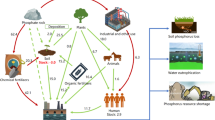Abstract
The bacteriumPseudomonas sp. strain RW31 isolated from the river Elbe utilized the ammonium salt of 4-sulfophthalate (4SPA) as sole source of carbon, sulfur, nitrogen, and energy and grew also with phthalate (PA) and several other aromatic compounds as sole carbon and energy source. The xenobiotic sulfo group of 4SPA was eliminated as sulfite, which transiently accumulated in the culture supernatant up to about 10 µM and was slowly oxidized to the stoichiometrical amount of sulfate. Biodegradation routes of 4SPA as well as of PA converged into the protocatechuate pathway and from found activities for the decarboxylation of 4,5-dihydroxyphthalate we deduce this compound the first rearomaticized intermediate after initial dioxygenation. Protocatechuate then underwentmeta-cleavage mediated by a protocatechuate 4,5-dioxygenase activity which was competitively inhibited by the structurally related compound 3,4,5-trihydroxybenzoate; protocatechuate accumulated in the medium up to an about 2 mM concentration. Indications for the presence of selective transport systems are presented.
Similar content being viewed by others
References
Bartels I, Knackmuss H-J & Reineke W (1984) Suicide inactivation of catechol 2,3-dioxygenase fromPseudomonas putida mt-2 by 3-halocatechols. Appl. Environ. Microbiol. 47: 500–505
Bertolacini RJ & Barney JE (1957) Colorimetric determination of sulfate with barium chloranilate. Analyt. Chem. 29: 281–283
Brilon C, Beckmann W & Knackmuss H-J (1981) Catabolism of naphthalenesulfonic acids byPseudomonas sp. A3 andPseudomonas sp. C22. Appl. Environ. Microbiol. 42: 44–55
Crawford RL (1975) Novel pathway for degradation of protocatechuic acid inBacillus species. J. Bacteriol. 121: 531–536
Eaton RW & Ribbons DW (1982) Metabolism of dibutyl phthalate and phthalate byMicrococcus sp. strain 12B. J. Bacteriol. 151: 465–467
Edwards GA, Perkin jun. WH & Stoyle FW (1925) New synthesis of the meconines. J. Chem. Soc. 127: 195–199
Endo K, Kondo H & Ishimoto M (1977) Degradation of benzenesulfonate to sulfite in bacterial extracts. J. Biochem. 82: 1397–1402
Feigel BJ & Knackmuss H-J (1988) Bacterial catabolism of sulfanilic acid via catechol-4-sulfonic acid. FEMS Microbiol. Lett. 55: 113–118
Groenewegen PEJ, Driessen AJM, Konings WN & De Bont JAM (1990) Energy-dependent uptake of 4-chlorobenzoate in the coryneform bacterium NTM-1. J. Bacteriol. 172: 419–423
Hansen C, Fortnagel P & Wittich R-M (1992) Initial reactions in the mineralization of 2-sulfobenzoate byPseudomonas sp. RW611. FEMS Microbiol. Lett. 92: 35–40
Johnston JB, Murray K & Cain RB (1975) Microbial metabolism of aryl sulfonates, a re-assessment of colorimetric methods for the determination of sulphite and their use in measuring desulfonation of aryl and alkylbenzene sulphonates. Antonie van Leeuwenhoek 41: 493–511
Klečka GM & Gibson DT (1981) Inhibition of catechol 2,3-dioxygenase fromPseudomonas putida by 3-chlorocatechol. Appl. Environ. Microbiol. 41: 1159–1165
Locher HH, Leisinger T & Cook AM (1991) 4-Sulphobenzoate 3,4-dioxygenase. Purification and properties of a desulphonative two-component enzyme system fromComamonas testosteroni T-2. Biochem. J. 274: 833–842
McOmie JFW, Watts ML & West DE (1968) Demethylation of aryl methyl ethers by boron tribromide. Tetrahedron 24: 2289–2292
Nakazawa T & Hayashi E (1978) Phthalate and 4-hydroxyphthalate metabolism inPseudomonas testosteroni: purification and properties of 4,5-dihydroxyphthalate decarboxylase. Appl. Environ. Microbiol. 36: 264–269
Ono K, Nozaki O & Hayaishi O (1970) Purification and some properties of protocatechuate 4,5-dioxygenase. Biochim. Biophys. Acta 220: 224–238
Quilico A (1927) Azione dell'acido amminosolfonico sui difenoli. Gaz. Chim. Ital. 57: 793–802
Ribbons DW & Evans WC (1960) Oxidative metabolism of phthalic acid by soilPseudomonads. Biochem. J. 76: 310–318
Sander P, Wittich R-M, Fortnagel P, Wilkes H & Francke W (1991) Degradation of 1,2,4-trichloro- and 1,2,4,5-tetrachlorobenzene byPseudomonas strains. Appl. Environ. Microbiol. 57: 1430–1440
Stanier RY & Ingraham JL (1954) Protocatechuic acid oxidase. J. Biol. Chem. 210: 799–808
Thurnheer T, Köhler T, Cook AM & Leisinger T (1986) Orthanilic acid and analogues as carbon sources for bacteria: growth physiology and enzymic desulphonation. J. Gen. Microbiol. 132: 1215–1220
Thurnheer T, Zürrer D, Höglinger O, Leisinger T & Cook AM (1990) Initial steps in the degradation of benzene sulfonic acid, 4-toluene sulfonic acid, and orthanilic acid inAlcaligenes sp. strain O-1. Biodegradation 1: 55–64
Wittich R-M, Rast HG & Knackmuss H-J (1988) Degradation of naphthalene-2,6- and naphthalene-1,6-disulfonic acid by aMoraxella sp. Appl. Environ. Microbiol. 54: 1842–1847
Author information
Authors and Affiliations
Rights and permissions
About this article
Cite this article
Richter, M., Wittich, RM. Mineralization of 4-sulfophthalate by aPseudomonas strain isolated from the River Elbe. Biodegradation 5, 63–69 (1994). https://doi.org/10.1007/BF00695215
Received:
Accepted:
Issue Date:
DOI: https://doi.org/10.1007/BF00695215




